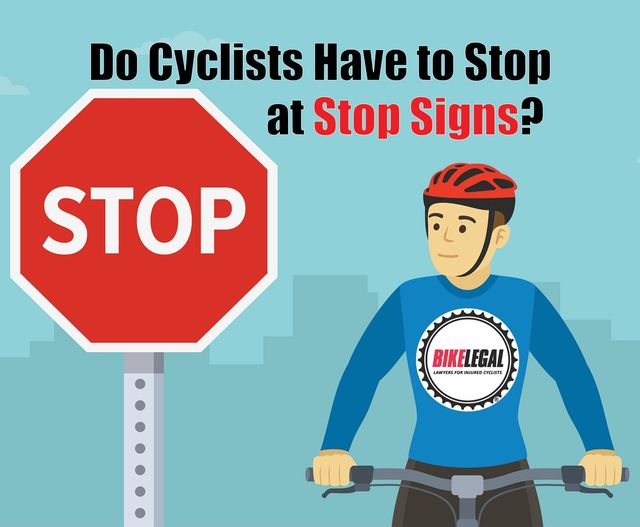Imagine you’re pedaling along a peaceful street, enjoying the fresh air and freedom that comes with riding your bicycle. Suddenly, you approach a stop sign.
What do you do? Your instincts might tell you to slow down, look around, and keep going if the coast is clear. But is that really what you’re supposed to do? This question might seem simple, but it can stir up quite a debate among cyclists and drivers alike.
Whether you’re a seasoned cyclist or a curious observer, understanding the rules of the road is crucial. Do bicycles have to stop at stop signs, just like cars do? Your safety and your rights as a cyclist depend on knowing the answer.
Let’s dive into the nuances and explore what the law says, what the common practices are, and why it all matters to you. Keep reading to uncover the hidden truths and learn how to navigate stop signs confidently on your next ride.
Bicycle Road Rules

Credit: www.bikelegalfirm.com
Understanding bicycle road rules is crucial for safe cycling. Bicyclists share the road with motor vehicles. They must follow rules for safety.
One common question is about stop signs. Do bicycles need to stop? The answer varies by location, but here’s what you should know.
Do Bicycles Have To Stop At Stop Signs?
In many areas, bicycles must stop at stop signs. They follow the same rules as cars. This means coming to a full stop. Cyclists should look both ways before crossing.
Some places have different rules. These places allow a rolling stop, sometimes called an “Idaho Stop.” This means cyclists can slow down and proceed if safe.
Understanding Local Traffic Laws
Laws for bicycles differ by region. It’s vital to know the local rules. Check local traffic laws to understand what’s required.
Some cities have specific bike lanes and rules. These laws can make cycling safer and more efficient.
Why Following Rules Is Important?
Following the rules ensures safety for everyone. It helps prevent accidents between cyclists and cars. Stopping at stop signs reduces confusion on the road.
Cyclists who obey the rules set a good example. It encourages respect from motorists.
Additional Safety Tips for Cyclists
Wear a helmet for safety. Use lights and reflectors to be visible. Signal your turns with hand signals. These actions improve safety and communication.
Stay alert and aware of your surroundings. Avoid distractions like headphones. Always ride predictably to ensure safety.
Impact On Cyclist Safety

Credit: www.bikelegalfirm.com
Stopping at stop signs affects cyclist safety. Bicycles must obey traffic laws to prevent accidents. Following rules creates safer roads for everyone.
The question of whether bicycles need to stop at stop signs is more than a legal matter. It directly impacts cyclist safety. For those who love cycling, understanding how to navigate stop signs can be a life-saving skill. Bicycles, unlike cars, are more vulnerable on the road. Their riders are exposed to the elements and have less protection in the event of a collision. So, how does stopping at stop signs play into this?
Understanding The Risks
Cyclists often face unique challenges at intersections. Drivers may not always see them, especially if they’re not stopping. Rolling through a stop sign might seem harmless, but it increases the risk of accidents. You might think you’re saving time, but you’re actually putting yourself in harm’s way.
Legal Requirements Vs. Practical Safety
In many areas, bicycles are legally required to stop at stop signs just like any other vehicle. However, there are regions where the “Idaho Stop” law allows cyclists to treat stop signs as yield signs. This law intends to keep cyclists safe by maintaining their momentum and allowing them to clear intersections quickly. Yet, the question remains: does this trade-off between legality and practicality benefit cyclist safety?
Personal Experience: A Lesson Learned
I remember a time when I thought rolling through a stop sign was no big deal. One day, while riding in a quiet neighborhood, I approached a stop sign. I looked both ways, saw no cars, and decided to keep going. Suddenly, a car came around the corner faster than I expected. I narrowly avoided an accident, and it taught me a valuable lesson about the unpredictability of other road users.
Impact On Traffic Flow
Stopping at stop signs can sometimes disrupt the flow of traffic, especially in busy areas. But for cyclists, the primary concern should be safety, not speed. While it may be frustrating to stop frequently, it ensures that you are seen by drivers. This visibility can be the difference between a safe ride and a dangerous encounter.
Engaging With Other Road Users
Communication is key on the road. Making eye contact with drivers at intersections can confirm that they’ve seen you. This simple action can prevent misunderstandings and accidents. So next time you’re at a stop sign, take a moment to connect with those around you.
Final Thoughts: What Would You Choose?
Consider the balance between convenience and safety. Is saving a few seconds worth the risk of a potential accident? The next time you’re on your bike approaching a stop sign, think about the choices you’re making. Your decision could have a significant impact on your safety and the safety of others.
Comparing Regulations By Region

Credit: streets.mn
Bicycles, like cars, are subject to traffic laws. Yet, these laws vary by region. Some places have strict rules for cyclists. Others offer more leniency. Understanding these regulations is vital for safe cycling.
United States
In the US, cycling rules differ from state to state. In some states, bicycles must stop at stop signs, just like cars. But others allow a “rolling stop.” Cyclists can slow down, check for traffic, and proceed if clear.
Canada
Canadian laws also vary by province. Most provinces mandate stopping at stop signs. Cyclists must follow the same rules as motor vehicles. Some regions, though, offer exceptions. They may allow cautious rolling stops.
United Kingdom
In the UK, cyclists must obey all traffic signals. Stop signs are no exception. Cyclists must come to a complete stop. This rule ensures safety and reduces accidents. However, enforcement may vary in rural areas.
Australia
Australian cyclists face strict rules. Stop signs require full stops without exception. Laws apply equally to cyclists and drivers. Regions may differ slightly in enforcement. But the rule remains the same across the country.
India
India has diverse cycling regulations. Urban areas enforce strict adherence to stop signs. Rural areas may have more relaxed rules. Cyclists should always prioritize safety. Understanding local laws is crucial.
Japan
Japan is strict about traffic laws for cyclists. Stop signs mean a complete stop. Cyclists must follow these rules without exception. This law helps maintain road safety. Cyclists are expected to be vigilant and cautious.
Knowing regional regulations is essential for cyclists. It helps ensure safety and compliance. Cyclists should always check local laws before riding.
Conclusion
Bicycles must obey stop signs like cars. Safety first on roads. Ignoring stop signs is dangerous and illegal. Respecting traffic rules protects everyone. Cyclists should watch for cars and pedestrians. Stop signs help manage traffic flow. They keep streets orderly and safe.
Riding responsibly shows respect for the law. It also ensures your safety. It prevents accidents and confusion. Practice safe cycling habits every day. Remember, safety is a shared responsibility. Following rules keeps everyone safe. Let’s make roads safer for all.



